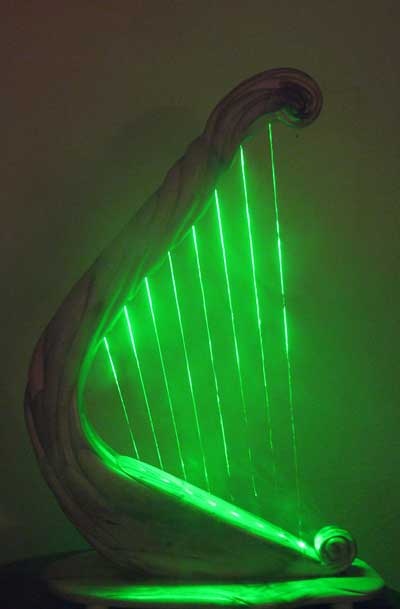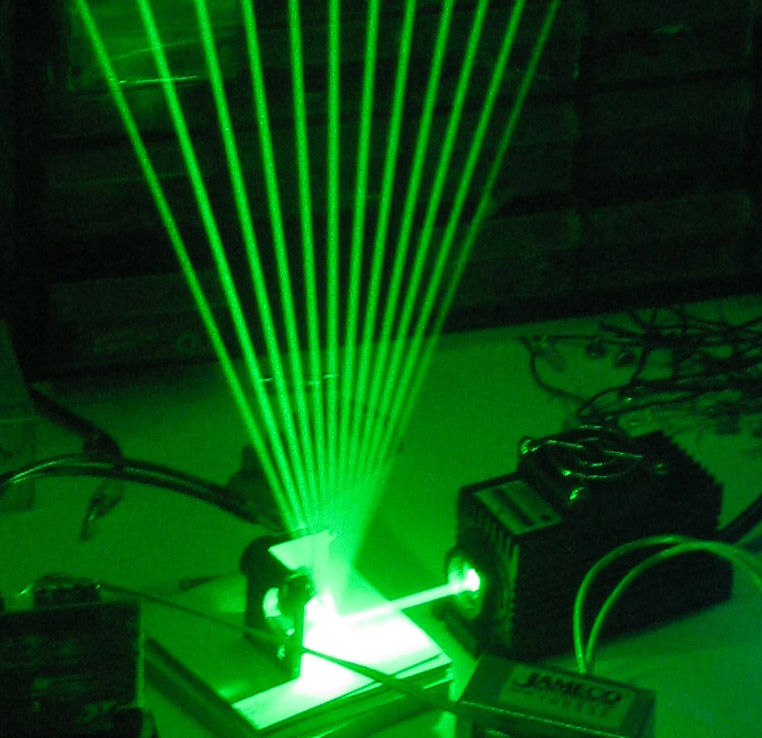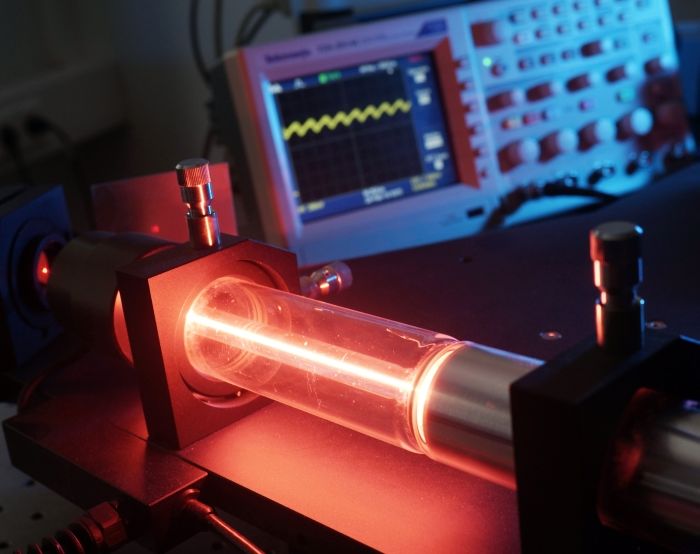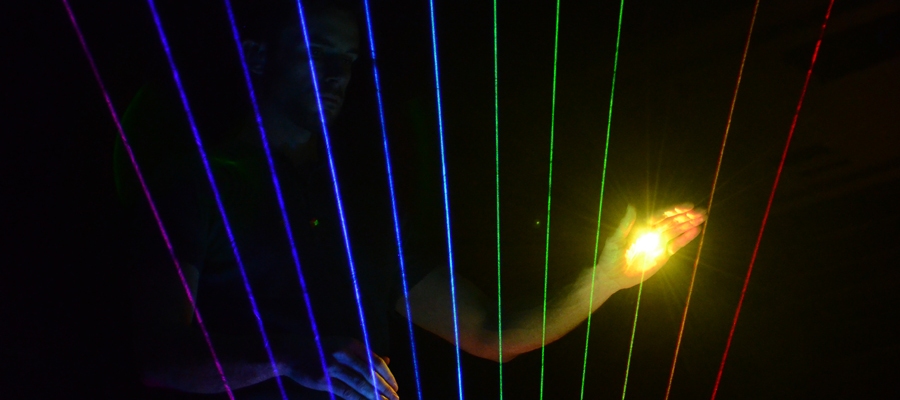Featured Image: Guy Berryman of Coldplay playing the laser harp (Ghost Stories Live 2014), Source: Coldplay
If you know me, you know that I’m an ardent Coldplay fan, and one fine day while spending few hours on YouTube browsing through their concerts, I came across a video from their concert in 2014 for their sixth album Ghost Stories. One of my favorite songs from the album happens to be Midnight, and I was amazed to see a beautiful instrument being played by the band for the song – something that triggered the scientist in me, and I looked it up right after. It’s called a laser harp, and I would like to share with you in the simplest words I can what this intangible musical instrument is and how it works as such a beautiful audio-visual delight.

I wouldn’t go into the details of lasers because we all know what they are – even if we don’t know how they work (if you are interested to know how Lasers work, drop a comment and I might try to write about it in another article).
In the meantime, you can watch this four-minute video:
The question is: What is a laser harp?
According to Wikipedia: “A laser harp is an electronic musical user interface and laser lighting display. It projects several laser beams—and a musician plays these by blocking them to produce sounds-reminiscent of a harp.”
The invention is attributed to two British men, Geoffrey Rose and Bernard Szajner, in the 1970s and was widely popularised by French composer Jean-Michael Jarre in the 1980s. So it has been around for quite a while, but not many people, including myself, were aware of it.
There can be different types of laser harps, and following are the four main types:
- Unframed/Infinite beam: A single laser is used, and the beam is split into parallel beams or like a fan arrangement. The light is reflected back to a photodiode.
- Bicolour/Fullcolour: It has sensors that can detect the height of the hand and reject ambient light.
- Unframed/Image recognition: There is a USB camera connected to a laptop computer that can detect the reflected light from the hand blocking the beam.
- Framed: It is made to look like a harp with strings and is connected to a series of photodiodes or photoresistors.
Okay so we are pretty much done with the introduction. If you didn’t follow much or found it boring, don’t worry. The next part will be much more fun. Let’s look at how this thing works, and by “this” I don’t mean a framed laser harp like this one:
 Source: mountainglenharps.com
Source: mountainglenharps.com
but an unframed one, like this one:
 Source: Instructables
Source: Instructables
Now there are many steps involved to make one, and in fact you CAN make one at home if you’re a tech-savvy person or have a friend who is, and if you are ready to spend a few hundred dollars. Look here, for example. But let me just assume that my job is to motivate you to build one, and not help you build one. For that I need to tell you what is the principle involved.
- First of all, you need a laser beam generator. I guess it can be obtained from a shop/company that sells optical instruments to Physics laboratories.
 A Helium-Neon Laser, Source: physicsopenlab.org
A Helium-Neon Laser, Source: physicsopenlab.org
- Next you need a mirror and a stepper motor. The beam is meant to be divided into a number of laser outputs, and this is what you need them for.
- So what do they do? First you direct the beam towards a mirror, which is further connected to a stepper motor. The stepper motor is an electromagnetic device which can convert short electrical impulses to fine mechanical movements. So every time your beam hits the mirror, it detects the impulse of the beam and its frequency, and causes its shaft to rotate in a particular speed and direction.
- Eventually the beam gets projected in different directions, but the swift movement of the shaft makes it look like all the beam parts are projected simultaneously.
- So now you have your multi-beam laser. The next step is to connect it to a photodiode or light sensor.
- Whenever a hand blocks one of the beams, the light is reflected back to the sensor. Since every beam corresponds to a particular motor position, the sensor then understands which position the blocked beam corresponds to.
- The sensor then feeds that information to a microprocessor like Arduino that is further connected to a computer, and the signal is converted to sound waves that we are able to hear.
Does that sound simple or too complicated? Well it’s basically a chain of devices that you need to connect together, and then program your computer accordingly. But if you want to know if the hard work and investment is worth it, give a listen to this electrifying rendition of LMFAO’s Party Rock Anthem on laser harp (an absolute delight for EDM fans!) :
Lastly, to understand even better, have a look at this smart video:

Looks cool and illuminated. Would love to see it in real.
LikeLike
Very interesting post. Lasers look so cool
LikeLike
Thanks for explaining how the laser harp works. I actually saw Jean-Michael Jarre last year here in Toronto. It was my first time seeing him live. I grew up hearing my dad blast his music lol. And my bf is also an electronic music player as well as composer and guitar player. Anyway back to Jarre, he did play it at the show and I thought it was very cool.
LikeLike
this harp looks dope, And for me the only thing cool about Coldplay! Jkjk It looks like a theremin only instead of it being just for the ears it’s also a light show
LikeLike
Wow!! That’s cool! I remember the first time I saw Blue Man Group, they use all kinds of crazy lighting and sounds for their shows. If you ever get a chance, go see them!!
LikeLike
The colorful illumination is cool. Interesting piece of music instrument. My daughter plays Clarinet! Thanks for sharing.
LikeLike
I didn’t know these existed! How crazy. To me, the process of making one sounds hard but I would love to play with one if I ever get the chance.
LikeLike
That looks like a fun and interesting instrument.
LikeLike
I am also a huge Coldplay fan so this was an interesting reading. I have never actually heard of something like this even though I have seen it being used. Nice to know how it works. Thanks for sharing!
LikeLike
Oh my gosh! That looks so fun and cool. I’d love to play one even though I’d have no idea what I was doing, lol! 🙂
LikeLike
Ah, this is fascinating! I’m also a Coldplay fan and these effects always fascinated me, love it! So, so cool 🙂 thanks for this research!
LikeLike
Wow!!! That’s super cool!! I also love Coldplay and I have to say that their shows are one of the best I’ve ever seen and I think (apart of the band of course) it’s because all the light effects and lasers. So I enjoyed reading your post and knowing a bit more about it!
LikeLike
Just curious about the safety visually to the one playing the harp and also safety of laser in hands playing same. Thanks. Really cool.
LikeLike
I guess while playing it’s not unsafe, because one laser beam is getting divided into many, so the power is much less. But one should be careful with the original laser, but that also comes in a glass casing.
LikeLike
Hi…thanks for the credit for my invention of the laser harp…I am Australian and Szaner is French however
I invented the harp in 1975, preempting
the Frenchman by many years..
You can see my harp on my laserspecialevents site…
Geoffrey Rose
LikeLike